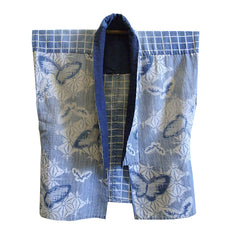A Katazome Han Juban or Half Under Kimono: Mixed Patterns
early to mid twentieth century
27 1/2" x 24", 70 cm x 62 cm
This is a completely hand stitched katazome dyed cotton han juban--or a half under-kimono. The han juban's original sleeves have been removed.
This is a boxy garment that if worn would be more like sculpture than a vest: it does not lay naturally against the body's shape, which, in Japan, was not an issue since this was to be hidden by a kimono whose shape, as you know, does not show off the human form.
The cotton shows patterns popular in the 1930s or so and the indigo is more than likely synthetic which was the fashion of the day.
The patterns clash beautifully: on the front we see a large repeat of good-sized butterflies. The back and shoulders show a white-on-blue grid pattern. Both the butterflies and the grid pattern show wear and fading, the grid pattern has a stain which is pictured on the accompanying detail photos.
The collar of the garment is wide and is shown here folded over on to itself.
A lovely garment from the early Showa period (1926 - 1989) and a great study in contrasting patterns.

